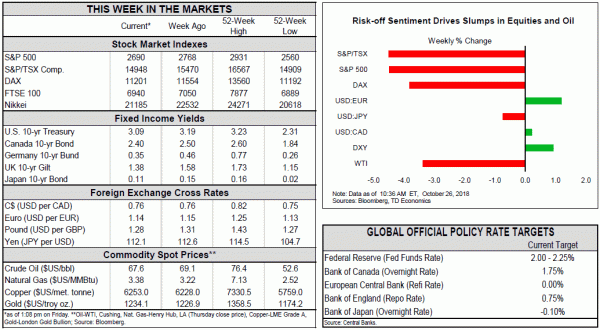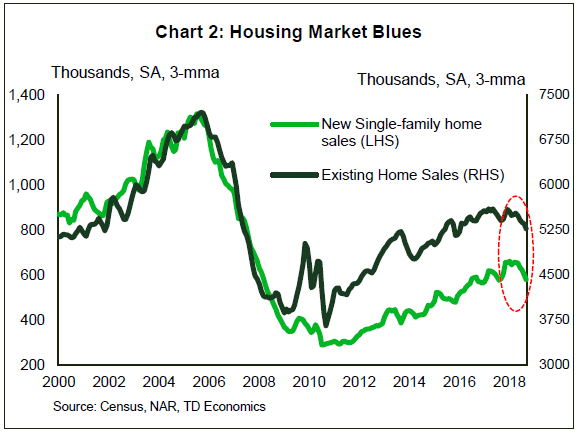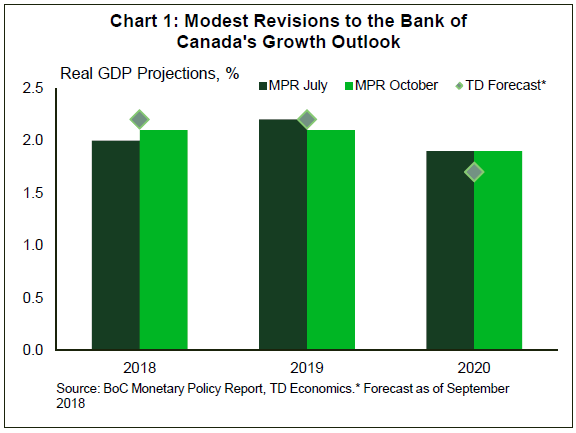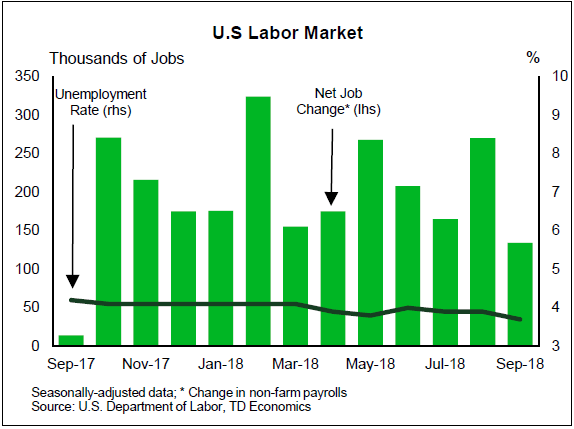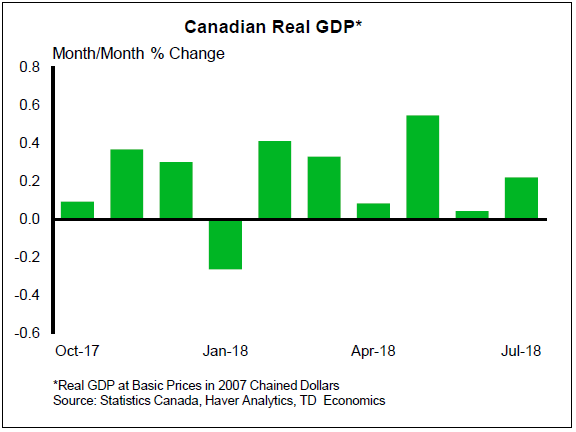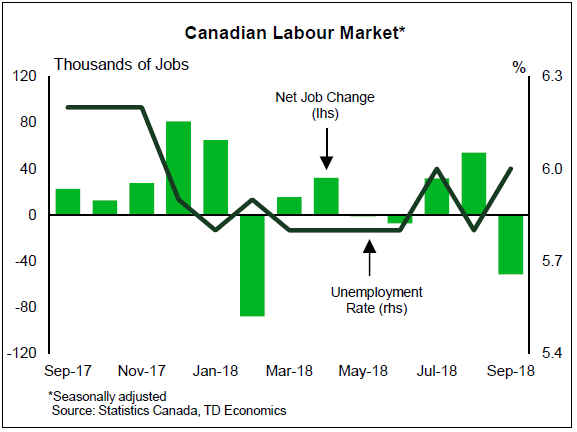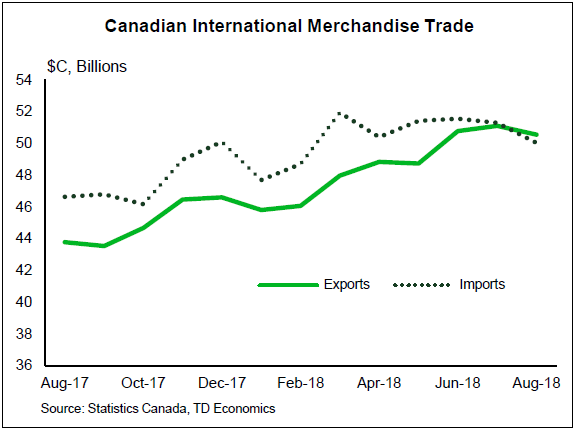U.S. Highlights
- It was a sea of red in equity markets this week as risk off sentiment set in. As it stands, downturn in October has erased all the stock market gains from the start of the year.
- International developments didn’t help to lift investors’ spirits. The U.S. – China trade negotiations appear to have hit a stalemate, and the European Commission has rejected Italy’s government budget.
- Domestically, the advance estimate of Q3 GDP was the only major data release this week. After an impressive Q2, the U.S. economy has downshifted slightly in Q3, but at 3.5% (annualized), growth has nonetheless remained very hot and well above potential, giving the Fed ammunition for another rate hike in December.
Canadian Highlights
- The Bank of Canada hiked its overnight interest rate by 25 bps to 1.75%, in a move that was unanimously expected and almost fully priced-in.
- In its relatively hawkish statement, most notable was the removal of its reference to “gradual” in its tightening approach, with the emphasis now on its path forward to a neutral rate, seen as sitting in the 2.50% to 3.50% range.
- The week saw few and unremarkable Canadian data releases, with an almost unchanged wholesale trade print, a modest decline in small business confidence, and a decent payrolls release.
U.S. – Economy is Hot, but Markets Worried About the Future
This was a tough week for financial markets. All major indexes fell precipitously, set to end the week deeply in the red. As it stands, markets’ downturn in October has erased all the gains from the start of the year. While domestic economy remains on solid footing and Q3 corporate earnings have so far exceeded expectations, investors’ conviction that corporate profits may have peaked is growing. Forward-looking investors are increasingly worried about slowing global growth, mounting trade tariffs, rising interest rates and a fading boost from fiscal stimulus.
International developments didn’t help to lift investors’ spirits. It seems that the U.S. – China trade negotiations have hit a stalemate. This threatens to undermine a scheduled meeting between the two presidents in November, and raises the probability of further tariffs. Also, in an unprecedented (even if widely expected) step, the European Commission has rejected Italy’s budget.
Domestically, there was relatively little on the economic radar this week, with the advance estimate of Q3 GDP the only major data release. As anticipated, after an impressive 4.2% print in Q2, the U.S. economy has downshifted slightly in Q3, but at 3.5% (annualized), growth nonetheless remained very hot and well above potential (Chart 1). Looking under the hood, consumer and government spending were both exceptionally strong, advancing by 4% and 3.3% in the quarter. Coming on the heels of a similarly robust 3.8% gain in Q2, this marks strongest two-quarter pace for consumer spending in over three years courtesy of a tight labor market and income tax cuts. .
Even as consumers are hitting malls in masses, the housing market remains unloved due to deteriorating affordability and lack of supply. Sales of new and existing homes are down by 11% and 6%, respectively, since December (Chart 2). With both homebuilders and prospective buyers facing a number of hurdles, residential investment has been contracting for three consecutive quarters.
Business investment was another fly in an ointment in today’s GDP report. After setting a blistering pace in the first half of the year, spending took a breather in the third quarter, up only 0.8%. While one quarter does not make a trend, given the tensions on trade front this is where the risks lie going forward. Tariffs have already dented business confidence and could lead to further delays in investment in the coming quarters. If investment spending continues to be soft, dampening economic growth, the Fed would likely temper the pace of rate hikes.
All in all, with trade risks percolating and the boost from fiscal stimulus expected to fade, performance over the last two quarters likely represents the high water mark for the U.S. economy. So far though, despite President Trump taking yet another jab at the Fed this week, it certainly looks like current economic fundamentals warrant another interest rate hike in December, bringing the upper end of the target range to 2.5%.
Canada – Speeding Up to Neutral
This week was thin on major Canadian data, with generally lackluster releases. Wholesale trade headline and volumes prints both edged down 0.1% on the month. Meanwhile, the payrolls report was positive but unremarkable, showing a modest gain of 0.1% in non-farm employment but unchanged weekly hours. Perhaps most informative was the CFIB small business confidence release, which, while edging lower, strongly reinforced the tightening labour market and capacity constraints narrative echoed in last week’s Business Outlook Survey.
Stealing the show this week, however, was the Bank of Canada. On Wednesday, the central bank hiked its overnight interest rate by 25 bps to 1.75%, the highest level since late 2008. The statement delivered a relatively hawkish tone, suggesting a still-positive global backdrop, and an improved Canadian outlook on the back of the recently agreed-upon USMCA. The Canadian growth estimate was upgraded 10 bps for 2018, but downgraded an equal 10 bps in 2019 and left unchanged in 2020. While this may look surprising given the resolution of USMCA and the bank’s upbeat tone, a slight downgrade to global growth and escalating U.S.-China trade uncertainty may have helped offset the USMCA upgrade. On the positive side, the Monetary Policy Report sees a shift from consumption to business investment and exports as drivers of GDP growth, a welcome assumption if realized given years of lagging investment.
Markets, however, were more attuned to the forward-looking aspects of the central bank’s statement. Specifically the removal of “gradual” helped push the OIS-implied probability of a December rate hike more than 10 p.p. up to 26%, before slightly falling off today. This removal also raised the implied likelihood of further hikes in 2019. We still maintain the view that a December rate is unlikely and a January rate hike is most probable, projecting a total of three hikes in 2019 to reach the lower end of the Bank of Canada’s 2.5%-3.5% neutral range. Supporting our view was a coinciding uptick in the market’s pricing of a January rate hike after the Bank of Canada’s decision. All told, the bank may be sending a message that slower headline inflation, as expected in its inflation outlook, will not be a major impediment to its path to neutral, especially in the face of positive data.
Of course, downside risks remain – with U.S.-China trade uncertainty being near the top, and tightening financial conditions in Canada likely weighing on consumption growth. Nevertheless, the USMCA agreement and the bank’s citing of stabilizing household vulnerabilities suggest that downside risks have moderated.
Meanwhile, Canadian markets were not spared the global risk-off sentiment, which heightened this week. Oil markets were negatively impacted, with benchmark WTI oil prices lower on the week. The energy-heavy S&P/TSX composite appears set to end the week down about 3.5% (as of 11 AM). Ongoing risk-off sentiment also didn’t help the Canadian dollar, which has continued to depreciate for its fourth straight week.
U.S.: Upcoming Key Economic Releases
U.S. Employment – October
- Release: November 2, 2018
- Previous: 134k, unemployment rate: 3.7%
- TD Forecast: 160k, unemployment rate: 3.7%
- Consensus: 190k, unemployment rate: 3.7%
We expect nonfarm payrolls to come in on the weak side at 160k in September, this time dampened by Hurricane Michael. The latter should more than offset any rebound from Hurricane Florence, which contributed to the weaker September print, in our view. We expect wages to lend a more upbeat tone to the report and rise 0.3%, taking the y/y pace to 3.2%. However we see risk for downward revisions.
Canada: Upcoming Key Economic Releases
Canadian Real GDP – August
- Release Date: October 31, 2018
- Previous: 0.2%
- TD Forecast: 0.0%
- Consensus: N/A
TD looks for a flat print on industry-level GDP for August, in line with observed weakness in activity data. Services should lead growth on further gains in real estate, which may be short-lived amid a recent pullback in home sales, and professional services while the goods sector will underperform. Residential construction will exert a drag on growth following a deceleration in housing starts while a decline in real manufacturing sales will provide another headwind to GDP. However, a rebound in the energy industry will provide a modest offset after production outages constrained oil sands output in July. While unchanged GDP might give the impression that data momentum is shifting to a lower gear, we still look for Q3 growth to print near 2% after the strong hand off from June, slightly above projections from the October MPR.
Canadian Employment – October
- Release: November 2, 2018
- Previous: 63k, unemployment rate: 5.9%
- TD Forecast: 5k, unemployment rate: 5.9%
- Consensus: N/A
The Canadian economy is projected to add 5k jobs in October on rebound in full-time hiring. LFS employment has oscillated in recent months but total job growth through August has sharply underperformed that reported by the Survey of Employment, Payrolls & Hours (SEPH) over 2018; while we do not expect that gap to close in one month, it does imply that we shouldn’t expect a full unwind of the September gains. However, we do expect some giveback in part time employment after 80k jobs were created in September and look for the construction sector to give up some of the 28k added jobs.
Our forecast is consistent with the unemployment rate holding at 5.9%, although the risks are tilted towards a tick lower should last month’s improvement in the participation rate correct. However, wage growth will be hard pressed to push higher given strong base effects. A 10% increase to Alberta’s minimum wage will help support the m/m print but this follows a more significant hike in 2017.
Canadian International Trade – September
- Release Date: November 2, 2018
- Previous: $0.5bn
- TD Forecast: $0.2bn
- Consensus: N/A
TD looks for the international trade surplus to narrow to $200m in September on a rebound in import activity while exports should see another modest decline, concentrated in energy products. Non-energy exports are likely to post a slight increase on a rebound in motor vehicles after auto exports fell by 6.2% last month. However, we do not expect a full recovery amid weaker production figures. Meanwhile imports should rebound on the heels of up upbeat advance trade data out of the US, which would represent the first increase since June.




